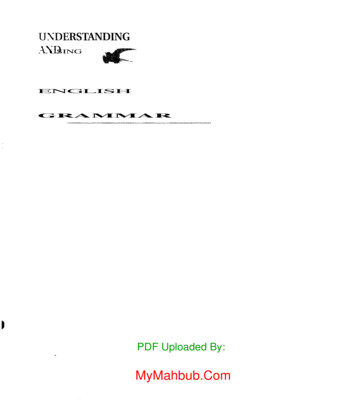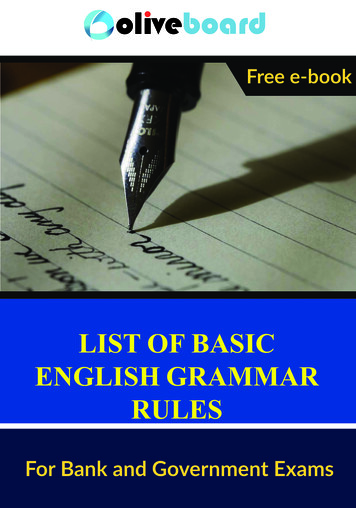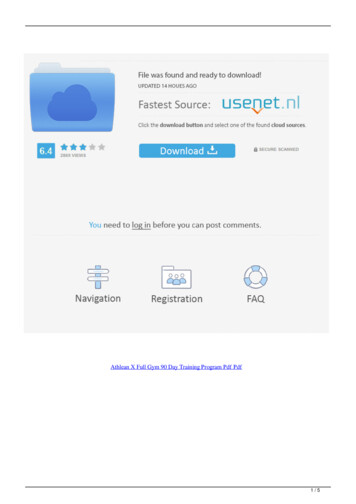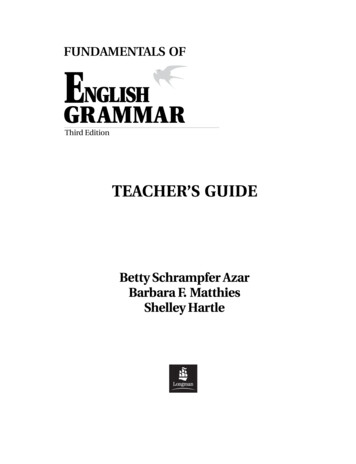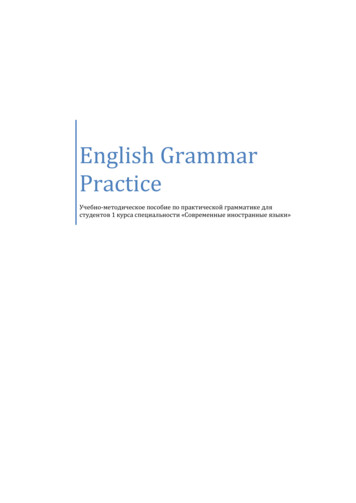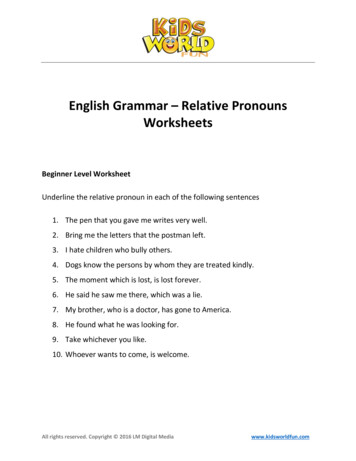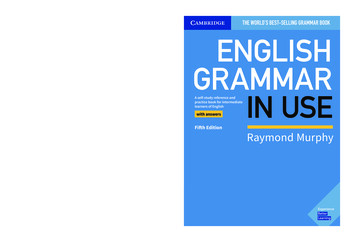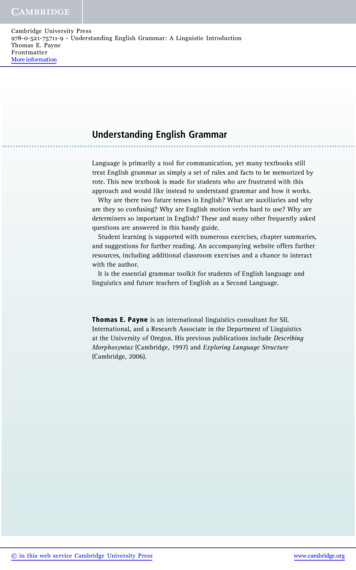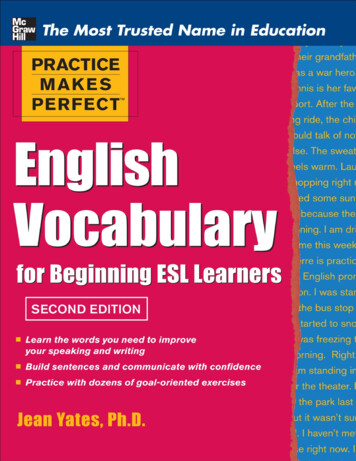
Transcription
Copyright 2012 by McGraw-Hill Education. All rights reserved. Except as permitted under the UnitedStates Copyright Act of 1976, no part of this publication may be reproduced or distributed in any form orby any means, or stored in a database or retrieval system, without the prior written permission of thepublisher.ISBN: 978-0-07-176304-2MHID:0-07-176304-XThe material in this eBook also appears in the print version of this title: ISBN: 978-0-07-176303-5,MHID: 0-07-176303-1.eBook conversion by codeMantraVersion 2.0All trademarks are trademarks of their respective owners. Rather than put a trademark symbol after everyoccurrence of a trademarked name, we use names in an editorial fashion only, and to the benefit of thetrademark owner, with no intention of infringement of the trademark. Where such designations appear inthis book, they have been printed with initial caps.McGraw-Hill Education eBooks are available at special quantity discounts to use as premiums and salespromotions, or for use in corporate training programs. To contact a representative please visit the ContactUs pages at www.mhprofessional.com.Trademarks: McGraw-Hill, the McGraw-Hill Education logo, Practice Makes Perfect, and related tradedress are trademarks or registered trademarks of McGraw-Hill Education and/or its affiliates in theUnited States and other countries and may not be used without written permission. All other trademarksare the property of their respective owners. McGraw-Hill Education is not associated with any product orvendor mentioned in this book.TERMS OF USEThis is a copyrighted work and McGraw-Hill Education and its licensors reserve all rights in and to thework. Use of this work is subject to these terms. Except as permitted under the Copyright Act of 1976 andthe right to store and retrieve one copy of the work, you may not decompile, disassemble, reverseengineer, reproduce, modify, create derivative works based upon, transmit, distribute, disseminate, sell,publish or sublicense the work or any part of it without McGraw-Hill Education’s prior consent. You mayuse the work for your own noncommercial and personal use; any other use of the work is strictlyprohibited. Your right to use the work may be terminated if you fail to comply with these terms.THE WORK IS PROVIDED “AS IS.” McGRAW-HILL EDUCATION AND ITS LICENSORS MAKENO GUARANTEES OR WARRANTIES AS TO THE ACCURACY, ADEQUACY ORCOMPLETENESS OF OR RESULTS TO BE OBTAINED FROM USING THE WORK, INCLUDINGANY INFORMATION THAT CAN BE ACCESSED THROUGH THE WORK VIA HYPERLINK OROTHERWISE, AND EXPRESSLY DISCLAIM ANY WARRANTY, EXPRESS OR IMPLIED,INCLUDING BUT NOT LIMITED TO IMPLIED WARRANTIES OF MERCHANTABILITY ORFITNESS FOR A PARTICULAR PURPOSE. McGraw-Hill Education and its licensors do not warrant orguarantee that the functions contained in the work will meet your requirements or that its operation will be
uninterrupted or error free. Neither McGraw-Hill Education nor its licensors shall be liable to you oranyone else for any inaccuracy, error or omission, regardless of cause, in the work or for any damagesresulting therefrom. McGraw-Hill Education has no responsibility for the content of any informationaccessed through the work. Under no circumstances shall McGraw-Hill Education and/or its licensors beliable for any indirect, incidental, special, punitive, consequential or similar damages that result from theuse of or inability to use the work, even if any of them has been advised of the possibility of suchdamages. This limitation of liability shall apply to any claim or cause whatsoever whether such claim orcause arises in contract, tort or otherwise.
ContentsIntroductionHow to Use This BookPART I NounsUnit 1 People and PlacesWords for PeopleWords for PlacesUnit 2 Singular, Plural, and Noncount NounsUsing Singular NounsUsing Plural NounsUsing Noncount NounsUsing Articles with Singular, Plural, and Noncount NounsUsing Demonstrative Pronouns with Singular, Plural, and Noncount NounsUnit 3 Proper NounsUnit 4 Possessive Nouns and PronounsPossessive NounsPossessive PronounsUnit 5 Review of Singular, Plural, and Noncount NounsUnit 6 Verbs Used as NounsUnit 7 More Specific NounsWords for PeopleWords for the ArtsWords for PlacesWords for ThingsWords for EventsPART II Adjectives
Unit 8 Making DescriptionsAdjectives That Describe PeopleAdjectives That Describe a Person’s ConditionAdjectives That Describe ObjectsAdjectives That Describe PlacesAdjectives That Describe the WeatherUnit 9 Comparisons and SuperlativesMaking an Adjective Stronger or WeakerMaking Comparisons with AdjectivesExpressing SuperlativesUnit 10 Verbs and Nouns Used as AdjectivesVerbs Used as AdjectivesNouns Used as AdjectivesUnit 11 Adjective OrderPART III VerbsUnit 12 The Verb BeThe Present Tense of BeAsking Questions with BeMaking Be NegativeThe Past Tense of BeUnit 13 Non– To Be VerbsRegular Present Tense Forms of Verbs Other than BeRegular Past Tense FormsVerbs That Describe Usual ActivitiesIrregular Past Tense FormsVerbs Used for Household ActivitiesVerbs Used in a ClassroomMaking Verbs NegativeActivities That Are Often Performed in an OfficeAsking QuestionsVerbs Used for ShoppingVerbs Used in a BankUsing the Present Progressive TenseVerbs Used for Outdoor Activities
Verbs Used for Activities in Public PlacesUsing the Present Perfect TenseVerbs Used for Leisure ActivitiesVerbs Used for CookingGiving DirectionsPART IV AdverbsUnit 14 Adverbs of Place, Time, and FrequencyAdverbs of PlaceAdverbs of TimeAdverbs of FrequencyUnit 15 Adverbs of MannerForming Adverbs from AdjectivesComparing AdverbsUnit 16 Adverbs That ModifyAdverbs That Modify VerbsAdverbs That Modify Adjectives and Other AdverbsPART V English in the Twenty-First Century: TechnologyUnit 17 General Vocabulary for TechnologyNounsAdjectivesVerbsUnit 18 Contacting Other People: The Technology of CommunicationsThe TelephoneThe Fax MachineThe Internet for CommunicatingUnit 19 Getting Information: The MediaNewspapers and MagazinesTelevision for Getting InformationThe Internet for Getting InformationUnit 20 EntertainmentTelevision/TV for EntertainmentAudio Devices
Reading Devices/Electronic Books/E-ReadersCamerasUnit 21 Technology in Other PlacesFor TravelingFor BankingFor ShoppingEverywhere ElseAnswer Key
IntroductionIt is not easy to know how to start learning new words in a language that is not your native one. Mostsecond-language learners depend on a favorite dictionary to get a quick translation of an unknown word;however, dictionaries are full of words that you may never need to use, or even to understand. How doyou know which words to learn first?One of the purposes of this book is to acquaint you with the English words that are most frequently used inthe United States today—the words that people use every day with their family, friends, coworkers, andother people in the community in general. Presented here is a basic vocabulary of more than fifteenhundred words that have been carefully chosen because of their frequent appearance and usefulness indaily life. Once you have learned these words and mastered the structures in which they are used, youwill be well equipped to add new words to this list, and you’ll gradually continue to increase yourworking vocabulary.The words of a language can be divided into two groups: content words and function words. Contentwords in English are either nouns—words that name people, places, things, or abstracts; adjectives—words that describe nouns; verbs—words that describe the actions of nouns; or adverbs—words thatdescribe how an action is performed. Function words are those that form a structure that enables us to putthe content words together to make sense. English function words include, for example, words such as a,the, of, for, and and—words that would be difficult to draw a picture of or to define in a word or two.Both types of words are extremely important for communication in any language.The second purpose of this book is to provide practice in using content words within the framework ofthe function words that go with them. By practicing these two types of words together you will be not onlylearning new vocabulary but also using it correctly, enabling you to form meaningful sentences with avariety of individual words.There are four sections in the book: Part I: Nouns, Part II: Adjectives, Part III: Verbs, and Part IV:Adverbs. Each of these parts contains a number of units, and each unit consists of special vocabulary for acertain topic and extensive exercises to practice it.
How to Use This BookThe best way to learn new vocabulary is to use it, both in speech and in writing. The exercises in thisbook are designed to give you that practice by encouraging you to write down exactly what you would sayin the context provided. The repetition of words and structures in various types of exercises will help youremember the words and make them yours to use in real situations.Following are suggestions to help you get the most out of this book:1. Get a good dictionary, either bilingual or English only, to use as suggested below.2. Copy on a separate sheet of paper the lists of words presented in each unit.3. You will already know some of the words. Write a check by each one if you are certain of itsmeaning.4. Look up in your dictionary the words that you do not know or are not sure of, and write a word inyour language or a definition in English next to it on your paper.5. Do the written exercises for the entire unit.6. In the exercises that ask you to write personal sentences, try to use words that are new to you. Ofcourse, if the new words do not fit, use words that you already know.7. Compare your answers with those in the Answer Key at the back of the book. For the exercises thatrequire personal answers, you may wish to ask a native speaker friend to read your answers to see ifthey are correct.8. Go back to your original list, cover up the translations or definitions that you first wrote, and see ifyou now know all the new words.9. Try writing more sentences, using the same patterns used in the exercises, to further practice thewords that you haven’t completely mastered so far.10. Keep practicing!
PART INOUNSNouns are the words we use to name all the things we know about, have, see, hear, taste, smell, or feel.This includes words for people, such as man, teacher, and friend. It includes words for places, such ascity, kitchen, and street. It includes words for things, such as ball, tree, and computer. And it includeswords for things we know exist but can’t touch, such as idea, air, pollution, and strength.Many nouns can be counted—one friend, two friends, for example. These nouns have plural forms, whichin English usually means they have an -s added to the end, according to certain set spelling andpronunciation patterns. A few nouns have “irregular” plurals—instead of ending in -s, they have formsthat have survived from earlier forms of English or were adapted from other languages. Examples of theseinclude women, men, children, media, and phenomena.Other nouns cannot be counted—air, wind, and pollution, for example. They have no plural forms, areused with singular verbs, and are called “noncount” nouns. But noncount nouns can also be things that wecan count! First, there are those that it would take a lifetime to count, so we call them by a more generalnoncount noun, such as hair, sugar, or flour. And then there are those that we categorize in general groupsthat are named by noncount nouns, such as furniture, mail, silverware, and china. Of course we can countchairs, tables, or beds, but the general category furniture is never made plural. The noncount noun mailincludes the letters and cards that we can count. English has a lot of these words.One thing that singular, plural, and noncount nouns have in common is that they can all, in certainsituations, be preceded by the article the. The before a noun indicates that both the speaker and the hearerknow exactly which one of the nouns is being referred to. “The groceries are in the car,” for example,informs the hearer that “the groceries that we just bought” are in “the car that we have.”When you know the patterns for using nouns, you can add new ones to your vocabulary every day andknow you are using them correctly. Have fun with nouns!
Unit 1People and PlacesWords for PeopleMembers of the FamilyReview the words in the following list:To identify a member of the family of someone’s husband or wife, add in-law after the relationship word.For example, a man’s mother-in-law is his wife’s mother.exercise 1-1Fill in each blank with a word from one of the preceding lists.1. My father’s mother is my .2. Her husband is my .3. My mother’s sister is my .4. Her husband is my .5. Their daughter is my .6. My daughter’s husband is my .7. I am a , ,
, ,, and .8. I have a , ,, ,, and .Categories for PeopleReview the words in the following list:exercise 1-2Match each word from the list on the left with its description on the right.Names of WorkersReview the words in the following list:
exercise 1-3Circle the word that best completes each sentence.1. When I am sick I see a .lawyer carpenter doctor police officer2. The person who gives traffic tickets is a .singer lawyer firefighter police officer3. The person who lives near my house is my .firefighter neighbor military officer journalist4. Medicines are prepared at the drugstore by a .mechanic nurse pharmacist sales assistant5. If I have a toothache, I see a .janitor doctor dentist technicianParts of the BodyReview the words in the following list:
exercise 1-4Fill in the blanks.1. The , , , , , ,, , and are on the head.2. The elbow is in the middle of the .3. The is in the middle of the leg.4. The is between the hand and the arm.5. The is between the foot and the leg.6. The foot has five ; the hand has four and one .7. The shoulders are between the and the .8. The is above the stomach and below the chest.Words for PlacesOutside PlacesReview the words in the following list:
exercise 1-5Circle the word that does not belong in each group.exercise 1-6What places do you go to every day?exercise 1-7What places do you go to once or twice a week?
exercise 1-8What places do you go to occasionally (sometimes)?exercise 1-9Where do you never go?Inside PlacesReview the words in the following list:exercise 1-10Write the name of the place or places where each of the following things is usually found.
Unit 2Singular, Plural, and Noncount NounsUsing Singular NounsEnglish nouns can be divided into two categories: count nouns and noncount nouns.A count noun is singular when there is one of the person, place, or thing it names.When a noun is singular, use a or an before it. Use a if it begins with a consonant sound; use an if itbegins with a vowel sound.exercise 2-1Write a or an before each of the following singular nouns.1. brother2. aunt3. artist4. employer5. janitor6. professor7. patient8. engineer9. reporter10. stewardess11. sister12. uncle13. dentist14. driver15. actor
16. adviser17. accountant18. technician19. architect20. actress21. cheek22. chest23. leg24. ear25. mouth26. area27. apartment28. river29. bus stop30. basement31. elbow32. arm33. ankle34. nose35. eye36. library37. house38. ocean39. airport40. attic
Use a or an before a singular noun to answer the question “What . . .?”Use the number one before a singular noun to answer the question “How many . . .?”Use “There is . . .” before a singular noun to indicate that it exists.There is an accountant in my family.There is a library on the corner.There is only one bus stop on this street.exercise 2-2Look at page 13 of this book and answer the following questions. Be careful in your choice of a, an, orone before each singular noun.1. What do you have in your hands?2. What is there at the very end of this book?3. In the word Contents, what is there between the first n and the e?4. How many e’s are there in the word Contents?Words for Groups of PeopleSome singular nouns name groups of people who have the same interest. These are called collectivenouns. Use a collective noun with a singular verb form. Observe the following examples:
exercise 2-3Fill in each blank with a word from the previous list. Be sure to include a or an in each blank beforethe noun.1. A group of people who take a course together is .2. A group of people who play musical instruments together can be or.3. A group of people who form a business is .4. People who are related by blood are .5. A group of people who play together to win a game or sport is .6. A group of people who control public policy in a country is .7. A group of people who make plans for a larger group is called .8. A group of people who sing together is or.Using Plural NounsA count noun is plural when there is more than one of the person, place, or thing it names. To make asingular noun plural: Add -s: Add -es to a few words that end in -o: Add -es to nouns that end in -ch, -sh, -ss, and -x: Add -ies to nouns that end in a consonant followed by -y, after dropping the -y:
Add -ves to nouns that end in -f or -fe, after dropping the -f or -fe: Use an irregular form for certain nouns: Use the singular form for the plural for certain nouns:exercise 2-4Write the plural form of each of the following nouns.
exercise 2-5Write the plural form of each of the following collective nouns.Use are there and a plural noun in a question to ask if any exist and how many:Are there any cars in your driveway?How many cars are there?How many houses are there on this street?How many pages are there in this book?Use there are followed by any number from two on up before a plural noun to tell how many of themexist:There are two cars in the driveway.There are ten houses on this street.There are 208 pages in this book.Use there are before the word no when it indicates zero. No is followed by a plural noun:There are no cars in the driveway.There are no houses on this street.Not any can be used instead of no to indicate zero:Words for Clothes and AccessoriesReview the following examples:
exercise 2-6Select twelve items from the preceding list, and write how many of each item there are in your closetsand drawers. Use There are to begin each sentence.1.2.3.4.5.6.7.8.9.10.11.12.PairsSome clothing items are usually in two parts, which are sometimes separate, such as two gloves, andsometimes connected, such as pants. The nouns are plural. One set of two parts is a pair. A pair of shoes,for example, is two shoes, one for the left foot and one for the right. A pair of pants is one item, with two
legs.Review the following examples of pairs:exercise 2-7How many pairs do you have in your closets and drawers?I have one pair of , one pair of , and one pair of.I have pairs of ,pairs of , and pairs of.QuantitiesTo tell an approximate number of plural items there are, use:I have some tickets for the ball game.There are a few seats in the front row.A lot of people are going to the game.There are not many seats.There are too many people here.exercise 2-8Look at all of the lists of nouns for people, places, and things to answer the following questions.1. What do you have some of? Begin each answer with I have . . .
2. What are there a lot of outside? Begin each answer with There are . . .3. What are there not many of in the place where you live? Begin each answer with There are . . .4. What do you see a few of right now? Begin each answer with I see . . .5. What do you have too many of? Begin each answer with I have . . .
Words for FoodReview the following words that name things to eat or drink. These nouns can be either singular or plural.exercise 2-9Write one of the following words or groups of words in each blank, depending on whether the nounsare singular or plural.aan onesomea lot ofa few noanytwo1. He eats egg and doughnut for breakfast.2. I like to have apple or orange in the afternoon.3. Would you like peas and carrots?4. She wants sandwich and potato chips.5. I want banana.6. We would like hot dogs, please.7. There aren’t hamburgers.8. She is going to the store to buy tomatoes.9. She’s going to buy steaks for dinner.
10. I didn’t order salad; I ordered vegetables instead.Using Noncount NounsMany words for food are noncount nouns. Some examples are the words in the following list:Many personal care items are also named by noncount nouns. Review the words in the following list:Use is there any before a noncount noun to ask if it exists:Is there any rice in the cupboard?Is there any fruit in the refrigerator?Is there any soap in the bathroom?Use how much followed by a noncount noun plus is there to ask the amount of it that exists:How much ice cream is there?How much cereal is there?How much water is there?How much shampoo is there?To tell the approximate amount of a noncount noun, use:There is some ice cream in the freezer.There is a lot of fruit in the bowl.There is a little cereal in the box.
There is not much shampoo.There is no water./There is n’t any water.exercise 2-10Use words from the noncount noun food list to answer the following questions.1. What is there a lot of in your refrigerator?2. Is there any candy in the cupboard?3. How much bread is there in the kitchen?4. Is there any popcorn in the cupboard?5. Is there too much of anything?exercise 2-11Use words from the noncount noun personal care items list to answer the following questions.1. Is there any shampoo in your bathroom?2. How much toothpaste is there?3. What else is there?To tell the exact amount of a noncount noun, use the singular or plural of the container of the item, theweight of the item, or the number of pieces or servings of it there are:
exercise 2-12Look at your answers to Exercise 2-10. Change the approximate amounts of each item to exactamounts and write the complete sentences here.1.2.3.4.5.exercise 2-13Look at your answers to Exercise 2-11. Change the approximate amounts of each item to exactamounts and write the complete sentences here.1.2.3.exercise 2-14Circle all of the words or sets of words that could be used in each blank.
1. There is bread on the table.a little a a lot of some three slices of no a slice of2. There are bread on the table.a little a few some three slices of an no3. We need ice cream.a littlesome three bowls of many a gallon of4. She drank milk.a glass of three glasses of a few sometwo quarts ofa little5. They’re going to buy rice.some a little a few two bags of a an one6. I would like to have lettuce on my sandwich.a piece of two pieces of a little a two some7. He ate cake.some a piece of piece of two pieces of threea lot of8. There is pie in the refrigerator.some a piece of piece of two pieces of no three9. There are cups of coffee here.a two one a few a littlesome no any10. I drink juice every morning.a two a glass of two glasses of some a lot of too manyWords for Groups of Individual ItemsOther noncount nouns include words that represent groups of individual items. The individual items canbe counted, but the word that represents the entire group cannot.
exercise 2-15Answer each question.1. How much furniture do you have?2. What mail do you usually receive?3. What jewelry do you like to wear?4. How much money do you have in your pocket?5. What do you throw in the trash every day?There are many things that cannot be counted. Like all noncount nouns, words for these things do not haveplural forms. Review the words in the following list:ThereThereThereThereThereis some housework to do.is a lot of news.is a little snow in the mountains.is not much heat in the house.is too much rain.
Do not use a, an, one, many, or any number with a noncount noun.exercise 2-16Circle all of the words that can be used in each blank space.1. We have help.many a little four an2. There is heat.no too many some a little3. They need advice.some an not many a lot of4. She has work.many some a little a an5. There is poverty in the city.a too much not many a lot ofexercise 2-17Answer the following questions. Use no, not much, some, a little, a lot of, or too much before eachnoncount noun.1. Do you have news about your friends in your country? Begin your answer with I have . . .2. Is there work available in this city? Begin your answer with There is . . .3. How much rain is there here in the summer? Begin your answer with There is . . .4. Do you need advice? Begin your answer with I need . . .5. Is there pollution in your area? Begin your answer with There is . . .Using Articles with Singular, Plural, and Noncount NounsThe indefinite articles a and an are used before singular nouns that refer to any one of that person, place,
or thing:A clock is an instrument that marks time.A watch is a clock that you wear on your wrist.The previous sentences do not name a specific clock or watch; they refer to clocks and watches ingeneral.The articles a and an can refer to a specific singular noun to tell or ask someone about it for the first time:I have a clock that is 150 years old.Her boyfriend gave her a watch for her birthday.There are no indefinite articles for plural and noncount nouns. To refer to people, places, or things ingeneral, no word (Ø) is placed before the plural or noncount noun:Ø Clocks are instruments that mark time.Ø Mail includes anything that can be delivered by the post office.No word (Ø) can refer to a plural or noncount noun to tell or ask someone about it for the first time:Her boyfriend brings her Ø flowers every week.You got Ø mail this morning.exercise 2-18Fill in each blank with one of the following.aanØ1. I am going to buy orange.2. They sell oranges at the market on the corner.3. Do you have fruit?4. Yes, we have oranges and apples.5. Where do they sell furniture in this city?6. I’m looking for table, chairs, and desk.7. We need information.8. Can you give me advice?9. Do you have kitchen equipment?10. I want to buy pot and frying pan.
The definite article the is used before a singular noun, a plural noun, or a noncount noun to refer to aspecific person, place, or thing.The is used when the speaker and the listener both know which particular item is being referred to:She showed me the watch her boyfriend gave her for her birthday.The flowers he sent her were beautiful.The furniture I bought was cheap.exercise 2-19Fill in each blank with one of the following:aanØthe1. I bought radio yesterday.2. Where is radio (you bought)?3. We have kitchen equipment on sale.4. Where is kitchen equipment (that you have on sale)?5. I love flowers.6. Are these flowers your friend sent you?7. Where is medicine the doctor gave you?8. Are these pills you are taking?9. He is looking for information.10. He didn’t like information he got from the company.exercise 2-20Write two sentences that tell about one thing you have. Use a or an in the first sentence to introduce it.Use the in the second sentence to tell more about it.1.2.exercise 2-21Write two sentences that tell about something you have more than one of. Use Ø in the first sentence to
introduce the items. Use the in the second sentence to tell more about them.1.2.exercise 2-22Write two sentences that tell about a noncount item you have. Use Ø in the first sentence to introduceit. Use the in the second sentence to tell more about it.1.2.The is used when there is only one possible reference:I left my keys in the car. (the car I drive)Please put the bags in the kitchen. (the only kitchen in the house)Please feed the dog. (the dog we own)exercise 2-23Fill in each blank with one of the following:aantheØ1. We bought car last night.2. cars are expensive.3. car we bought is a convertible.4. Do y
How to Use This Book The best way to learn new vocabulary is to use it, both in speech and in writing. The exercises in this book are designed to give you that practice by
